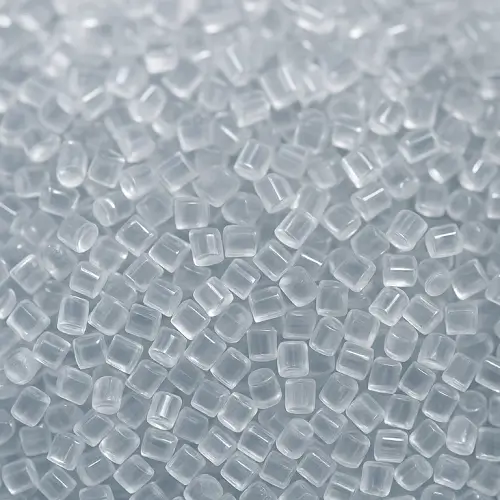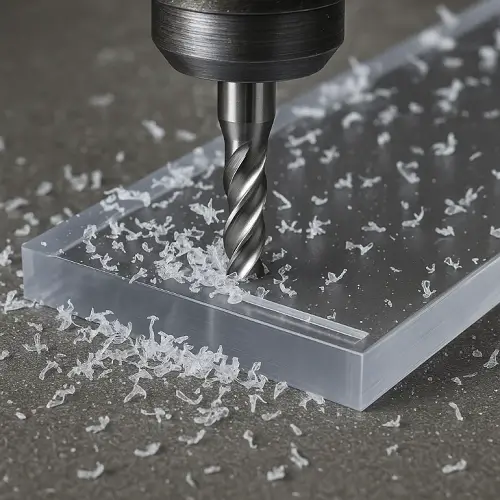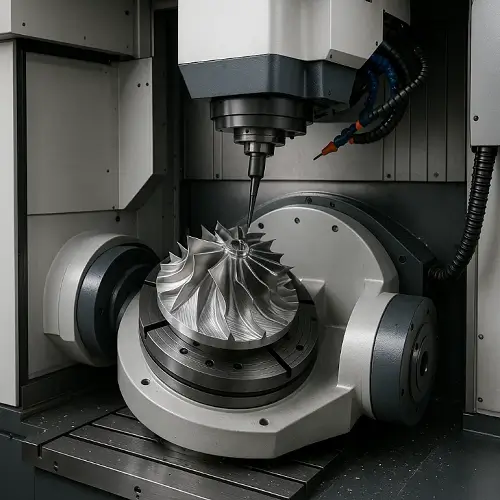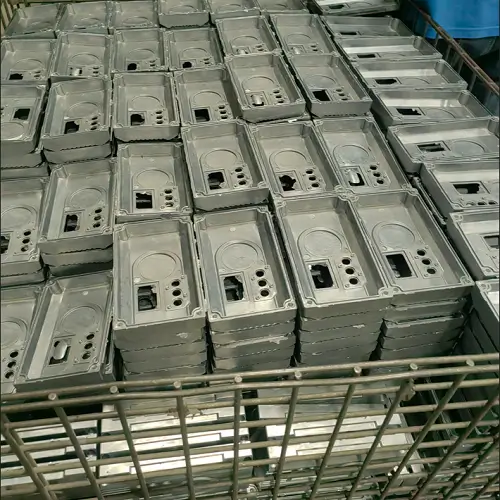Polycarbonate (Polycarbonate, referred to as PC) is a transparent engineering thermoplastics, both high impact strength, good heat resistance and optical transparency. Since its industrialization in the late 1950s by Germany’s Bayer (Bayer, trade name Makrolon) and the U.S. General Electric Company (GE, trade name Lexan), polycarbonate has become a representative material for transparent structural parts. It is widely used in machinery guards, light skylights, greenhouse panels, headlight covers, medical housings, optical lenses, and other applications that require a balance between strength and light transmission. In contrast, Acrylic (PMMA) is more common in display and decorative applications due to its high luster, ease of processing, and low cost. The relationship between the two is not a replacement, but rather a complement: acrylic is responsible for “aesthetics”, polycarbonate is responsible for “safety”.

What is Polycarbonate
From the molecular structure, polycarbonate is a kind of amorphous engineering thermoplastic (Amorphous Thermoplastic), the molecular main chain contains carbonate bond (-O-(C=O)-O-), gives the polycarbonate O-(C=O-) in the main chain of the molecule, which gives polycarbonate its unique toughness and transparency. Bisphenol A polycarbonate (BPA-PC) is commonly used in industry and is polymerized by either phosgene or ester exchange. The amorphous structure of the material is such that it does not break suddenly when subjected to force, but absorbs a large amount of energy and has very high impact resistance.
The light transmittance of polycarbonate is generally between 88-90%, which is slightly lower than that of acrylic, but the optical properties are stable and not prone to yellowing. Glass transition temperature of about 145-150 ° C, heat distortion temperature of 135-145 ° C, can be used for a long time at about 110 ° C without destabilization. Due to its good electrical insulation properties and dimensional stability, PC is widely used in electrical enclosures, connectors and instrument transparent windows.
Polycarbonate Performance Parameters
| Performance Items | Typical Values | Units | Engineering Description |
|---|---|---|---|
| Density | 1.20 | g/cm³ | about 50% lighter than glass |
| Transmittance | 88-90 | % | Optically transparent, slightly lower than acrylic |
| Refractive index | 1.586 | – | stable transparency |
| Notched impact strength | 850-900 | J/m | 200 times that of glass |
| Tensile strength | 60-70 | MPa | Combination of rigidity and toughness |
| Bending modulus | 2.3 | GPa | Good dimensional stability |
| Heat deflection temperature (1.8 MPa) | 135-145 | °C | Long-term use |
| Water absorption (24 h) | 0.15 | % | Drying before molding |
| Coefficient of linear expansion | 6.5×10⁻⁵ | 1/°C | Clearance required for assembly |
| Flame retardant | UL94 V-2 | – | can be modified to V-0 |
| UV resistance | Moderate | – | UV coatings are required to improve weathering resistance |
Advantages and Disadvantages of Polycarbonate
Polycarbonate is considered one of the most balanced transparent engineering plastics. Its combination of transparency, toughness, thermal stability and processability make it an ideal material for mechanical safety, lighting structures and optical covers.
Key Benefits
Polycarbonate has extremely high impact resistance and is able to maintain strength stability over a wide temperature range. It can be processed by injection molding, CNC, thermoforming, extrusion and many other techniques; compared with glass, it is lightweight and not easy to break. The material has good electrical insulation, dimensional stability and flame retardant properties, and is suitable for electrical and mechanical structural components.
Main Drawbacks
The surface hardness of polycarbonate is low and easily scratched, requiring a hard coating or composite with PMMA to improve wear resistance. Due to the sensitivity to alcohol and ketone solvents, it is not suitable for prolonged exposure to chemicals. Prolonged exposure to ultraviolet rays can cause yellowing, so UV-resistant coatings are required for outdoor use. In terms of cost, polycarbonate is slightly higher than acrylic.
The Difference Between Acrylic and Polycarbonate
Acrylic (PMMA) transparency of up to 92% or more, high surface hardness, polished like a mirror bright, is the display, signs and light boxes of choice. Its shortcomings are poor impact resistance, brittle, easy to crack in the drilling or assembly. Polycarbonate, although slightly less optically advanced, is extremely impact-resistant and will not shatter even when hit hard, so it is widely used in protective shields, mechanical viewing windows and helmet goggles.
For engineering purposes, acrylic is used when appearance is a priority, and polycarbonate is used when safety is a priority. The two are also often used in combination – acrylic on the outside for gloss and scratch resistance, and polycarbonate on the inside for strength and crack resistance. This “PMMA + PC” construction is common in displays, light boxes, instrument windows and industrial covers.
Double-Layer Polycarbonate Sheet
In the construction and agricultural sectors, Twin-Wall PC sheets are widely used in order to combine lightweighting, thermal insulation and light. The two layers of the panel are connected by longitudinal ribs to form an air cavity, resulting in excellent thermal insulation and structural strength. Compared to solid panels, Twin-Wall PC panels are lighter in weight, more rigid and have a lower heat transfer coefficient.
This structure is particularly suitable for greenhouses, skylights, factory light roofs, etc. The air cavity effectively reduces heat loss while maintaining good light diffusion and reducing glare. Aluminum alloy snap structure with sealing strip should be used for installation, and dustproof and drainage design should be added at the end. Panels with UV coating should be selected for prolonged outdoor exposure to prevent yellowing and micro-cracking.
Polycarbonate Lamination Application on Acrylic Sheet
Polycarbonate is often laminated with acrylic in applications that require both appearance and strength, such as display cabinets, advertising light boxes, and machine guards. Surface layer of acrylic to provide a high gloss appearance and scratch resistance, the back layer of polycarbonate to assume structural strength and impact resistance. The two layers are usually bonded with an optical film or structural adhesive, and the thickness and interlayer gap need to be calculated based on the difference in thermal expansion to prevent long-term warping.
This composite structure is both aesthetically pleasing and safe for displays and industrial equipment, and is now a common form for high-end panel systems.
Polycarbonate Lenses and “Polycarbonate Glass”
“Polycarbonate Lens” is a protective lens or shade made of optical-grade PC, commonly found in goggles, helmet masks, automotive lamps, and protective covers for electronic displays. Compared to glass, polycarbonate is about half the weight and hundreds of times stronger in terms of impact strength, and will not shatter to produce sharp-edged fragments.
“Polycarbonate Glass” is not really glass, but is the industry term for PC materials used in glass replacement applications such as security windows, blast shields, and viewing windows. Most optical-grade PC lenses are hardened and UV-coated to improve abrasion and aging resistance.
How to Cut and Process Polycarbonate Sheet
Polycarbonate has good machinability and can be shaped by CNC, table saw or laser cutting. Due to its low thermal conductivity and easy to melt, it is necessary to control the sharpness of the tool and the feed speed during processing to avoid melting edges caused by frictional heat.
For CNC milling, it is recommended to use microparticle carbide end mills with a cutting speed of 200-450 m/min, a feed of 0.03-0.08 mm per tooth, and a single-layer feed of 0.2-1 mm. Compressed air or atomized cooling effectively reduces the heat buildup.

Laser cutting is suitable for thin plates, but thicker plates may show discoloration or curled edges, and should be combined with subsequent flame polishing or vapor-phase polishing to restore transparency. Soft clamping or washers should be used during assembly to allow for thermal expansion and contraction gaps to avoid cracking.
Processing and Molding Recommendations
In actual production, the sharpness of the tool has a great impact on the surface quality, and a dull tool is prone to drawing and whitening. Before thermoforming or injection molding, the material should be fully dried, usually at 110~120°C for 4-6 hours to prevent silvering caused by moisture. UV-resistant grade is recommended for outdoor parts. For composite parts, check the bonding interface strength and long-term aging stability. jeekRapid optimizes the feeding and cooling solutions according to the part thickness, precision requirements and assembly methods to ensure stress-free and melt-free optics.
Industrial Applications of Polycarbonate
| Applications | Representative Products | Material Advantages |
|---|---|---|
| Architectural Lighting | Skylights, Greenhouses, Roof Panels | Lightweight, Insulated, Impact Resistant |
| Mechanical Manufacturing | Protective Hoods, Viewports | Safe, Transparent, Fatigue Resistant |
| Automotive & Transportation | Lamp Hoods, Instrument Covers | Heat Resistant, Ultraviolet Resistant |
| Medical Devices | Equipment Housings, Viewports | Sterilizable, Chemical Impact Resistant |
| Consumer Electronics | Power Supply Housings, Connectors | Insulating, Dimensionally Stable |
| Optical Lighting | Lamp shades, lenses | High light transmission, molding accuracy |
| Safety and protection | Helmets, goggles | High impact toughness, non-shattering |
JeekRapid’s Polycarbonate Processing Capabilities
JeekRapid has extensive experience machining clear plastics and can provide precision manufacturing services for polycarbonate and acrylic from prototype to mass production. We perform CNC milling, turning, thermoforming, and assembly with critical dimensional tolerances within ±0.02 mm.
For optical-grade parts, JeekRapid offers flame polishing, vapor polishing, fine grinding, and hard coating processes to achieve high clarity and surface finish. For composite structural parts, we can complete PMMA+PC laminate fabrication, UV coating, anti-fogging and edge sealing.
Upload your CAD files and JeekRapid will provide you with a quick quote and manufacturability assessment (DFM) to help you get high-quality polycarbonate parts in the shortest possible time.
FAQs
Q1: What is polycarbonate?
Polycarbonate is a transparent engineering plastic with high impact resistance, heat resistance, insulation and dimensional stability that is widely used in glass replacement parts.
Q2: Is polycarbonate a plastic?
Yes, it is. It is an engineering grade thermoplastic that can be molded with multiple heat cycles and maintain stable properties.
Q3: What are polycarbonate lenses?
Goggles or lampshades made of optical-grade PC are lightweight, shatterproof, and impact-resistant.
Q4: What is the difference between Plexiglass and Polycarbonate?
Acrylic has higher transparency and better appearance, while polycarbonate is tougher and more heat-resistant. Choose PMMA for appearance parts and PC for structural parts.
Q5: How do I cut polycarbonate sheets?
Use sharp tungsten carbide tools, medium speed feed and air cooling, after cutting, you can restore the transparency by flame or vapor phase polishing.
Q6:What is the use of double-layer polycarbonate sheet?
It is used in greenhouses, skylights, roofs, canopies and other architectural and industrial scenarios that require a combination of thermal insulation and impact resistance.


